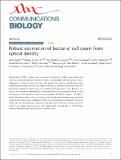Robust estimation of bacterial cell count from optical density
Date
17/09/2020Metadata
Show full item recordAbstract
Optical density (OD) is widely used to estimate the density of cells in liquid culture, but cannot be compared between instruments without a standardized calibration protocol and is challenging to relate to actual cell count. We address this with an interlaboratory study comparing three simple, low-cost, and highly accessible OD calibration protocols across 244 laboratories, applied to eight strains of constitutive GFP-expressing E. coli. Based on our results, we recommend calibrating OD to estimated cell count using serial dilution of silica microspheres, which produces highly precise calibration (95.5% of residuals <1.2-fold), is easily assessed for quality control, also assesses instrument effective linear range, and can be combined with fluorescence calibration to obtain units of Molecules of Equivalent Fluorescein (MEFL) per cell, allowing direct comparison and data fusion with flow cytometry measurements: in our study, fluorescence per cell measurements showed only a 1.07-fold mean difference between plate reader and flow cytometry data.
Citation
iGEM Interlab Study Contributors , Melo Czekster , C & Powis , S J 2020 , ' Robust estimation of bacterial cell count from optical density ' , Communications Biology , vol. 3 , 512 . https://doi.org/10.1038/s42003-020-01127-5
Publication
Communications Biology
Status
Peer reviewed
ISSN
2399-3642Type
Journal article
Description
Partial support for this work was provided by NSF Expeditions in Computing Program Award #1522074 as part of the Living Computing Project, and by the Engineering and Physical Sciences Research Council [EP/R034915/1] and EU H2020 [820699].Collections
Items in the St Andrews Research Repository are protected by copyright, with all rights reserved, unless otherwise indicated.

